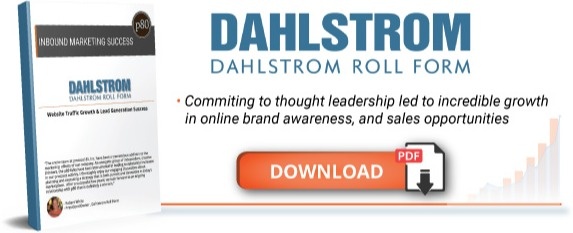Inbound Marketing Blog
for Manufacturers and Healthcare Companies
Inbound vs. Outbound Marketing: Why Is One Reaching Fewer People?
 Most every businessperson wishes they could predict the future and know whether it’s safe to jump on board a trend. Not surprisingly, many B2B markets (looking at you, manufacturing/industrial folks) are notoriously slow to move on from decades-old marketing tactics because they’re safe and require limited tech-savviness.
Most every businessperson wishes they could predict the future and know whether it’s safe to jump on board a trend. Not surprisingly, many B2B markets (looking at you, manufacturing/industrial folks) are notoriously slow to move on from decades-old marketing tactics because they’re safe and require limited tech-savviness.
Nowhere is this more apparent than the debate of inbound vs. outbound marketing.
You don’t need a crystal ball or Miss Cleo to see that buyers are going about their business differently these days. They’re wiser, more prepared, and more suspicious of sales pitches.
So, which marketing philosophy is attracting today’s buyers, and which smells more and more like an infomercial scam?
A 60-Second Recap of Inbound vs. Outbound Marketing
A quick review: What is inbound marketing? It’s a philosophy of using marketing to bring relevant viewers to your brand (hence the word “inbound”). Inbound attracts relevant traffic and leads by sharing valuable information like:
- Educational blog posts
- How-to and demo videos
- Email newsletters
- Whitepapers and e-books
This content helps a specific target group address specific problems and opportunities, guiding them closer to a purchase one day.
TL;DR version: Inbound marketing means helping.
So, then, what do we consider to be outbound marketing? This is where the brand stays in the driver’s seat, making first contact with the customer. Outbound sellers and marketers accomplish this through traditional channels like:
- Cold calling
- Cold emails
- Print/digital publication ads
- TV and radio commercials
TL;DR version: Outbound marketing means selling.
Does Inbound Marketing Work? Is Outbound Marketing Reaching Fewer Folks?
Outbound marketing is the megaphone that proactively tries to reach as many leads as possible.
Inbound marketing is more of a gentle (non-creepy) whisper in someone’s ear. It’s taken the execution and perceived value of “reach” in a totally different direction.
To show how the “reach everyone” philosophy isn’t as effective as the good-ol’ days, let us read your mind and address the questions you’re already thinking:
“Which one will generate more leads?”
There’s one massive, obvious sticking point with outbound marketing. (Other than its higher cost, but that’s a story for another time.)
What’s that sore spot? Nobody wants to be bothered anymore.
Here’s a stat for you … one that’s certainly gone up since it was published:
70% of buyers fully define their needs on their own before engaging with a sales representative, and 44% identify specific solutions before reaching out to a seller.”
If you don’t buy that, look at your personal habits. Do you:
- Click on the internet ads plastered on the sides of your browser window?
- Sit and watch every TV commercial when you could instead fast-forward or watch commercial-free?
- Listen to radio ads when you could instead listen ad-free on Spotify?
- Open your junk email?
- Open your physical junk mail?
- Buy magazines and newspapers?
Did you answer “Hell, no!” to any of them? The average B2B buyer today is doing virtually none of these things.
If it hasn’t already, this startling trend should cause you to reconsider how you approach B2B lead generation. Today’s buyer is looking for “pros and cons” blog posts and solution-comparing videos, not obnoxious sales pitches. Outbound marketing has never been that efficient at translating eyeballs to “I do”s, and it’s only gotten worse as more buyers take education into their own hands.
Shoving buyers toward the altar no longer works. Inbound marketing lets prospects progress at their own pace, offering helpful content that matches the stage of their buying journey.
 “Which one will increase brand awareness more?”
“Which one will increase brand awareness more?”
Both inbound and outbound can certainly bring attention to your brand. Heck, with a high enough budget, outbound marketing can get you in front of millions of eyeballs.
The differences are in relevancy and efficiency. The B2B brand awareness you spark from inbound marketing is more likely to lead somewhere. Outbound is more likely to waste both the marketer’s and the viewer’s time.
The reason is simple: These days, Awareness-stage prospects are doing their own research. They’re using the internet to diagnose and solve problems before a sales rep ever catches wind of their existence. So much for tarot cards.
Consider this stat:
Persona-based content marketing increased customer engagement almost 6x when targeting cold leads (10% versus 58%)”
B2B inbound marketing raises brand recognition by producing written and filmed content that:
- Educates
- Builds trust
- Showcases expertise
Using the megaphone approach of yelling “Buy from us today!!!” on your social media feeds, print ads, and cold emails can certainly raise your brand awareness … but not necessarily for the better.
“Which one will result in more sales?”
You can’t generate leads without brand awareness, and you can’t make sales without leads.
At its worst, interruptive marketing (the vulgar term for outbound marketing) casts an excessively wide traffic-generating net and ignores the specific needs of “not-quite-ready” leads. Poorly personalized brand experiences coupled with bad-fit lead generation will always = missed sales potential.
Just look at this “Spend Per Lead” chart to see how much outbound tactics are stifling revenue growth. Inbound marketing is actually a safer forecast* for growing a business digitally, especially for B2Bs with longer sales cycles.
*Disclaimer: Inbound marketing is a long-term strategy that requires patience to reap the benefits. Depending on the current quality of your website, it can be 6 months before you see traction, and 12+ months before traffic and leads really take off. But man, does it work.
Can You Use Both Inbound and Outbound Marketing?
We aren’t here to completely crap on traditional marketing tactics. (Seriously -- one of our most successful client relationships started with a cold call.)
Some of today’s successful tactics are a blend of outbound marketing with an inbound approach. Here are two examples:
ABM
Account-based marketing, or ABM, identifies a handful of “dream accounts” (say, five to 20) and creates a campaign extremely specific to their needs.
While it’s clearly “interruptive selling,” ABM for B2B fosters the personalized relationship these folks tend to love. Both ABM and inbound require deep understanding of your target buyer to inform what kind of content you make and where to distribute it. And both inbound and ABM focus on delivering a great buying experience throughout the entire customer journey.
Social Media (Paid) Advertising
B2B social media advertising represents another fascinating inbound-outbound mishmash.
Most sellers think of social media as a delivery vehicle for content marketing (which is a huge part of inbound marketing). This is true, but paid social advertising uses “push marketing” concepts that try to shorten the bridge between new visitor and willing buyer (just like outbound).
Benefits of paid social ads include:
- Can amplify reach better than organic (non-paid) posts
- Budget-friendly (some platforms more so than others)
- Can target by age, job role, hobbies, etc.
B2B social media strategies don’t always benefit from a huge reliance on in-your-face paid ads, so spend your budget wisely. For example, you may find the ROI is 100% worth it on LinkedIn, while Twitter brings you no leads at all. Or, maybe you’re already doing fine with organic posting, and don’t need paid ads at all.
Making the Stars Align With Inbound (or a Mix of Both)
In short, outbound marketing reaches more people who are less interested in the product, while inbound marketing is the inverse.
Yes, your goal is still to get a customer on your website, in your contact database, and eventually at your facility to sign a contract (followed by red wine or a Miller Lite). Inbound marketing is simply a more customer-centered way of doing it. That’s why it’s better at reaching B2B buyers with long sales cycles and highly custom needs.
Highly targeted and affordable, inbound marketing’s ROI will likely be too much for you or your boss to ignore in the future. It’s best executed by hiring an inbound marketing agency, though some companies have successfully used in-house staff to produce content and implement SEO best practices.
To see a real-life example of how inbound marketing reaches buyers, check out this case study:
Our Blogs, Direct to Your Inbox!
How to Audit your Online Marketing
If you are executing digital marketing, congratulations! You are most likely already one step ahead of your competition, and making strides to meaningfully connect with prospects online. But, how do you know if you’re seeing continual success year over year, and improving your metrics?
Without the tools in place to analyze and benchmark your efforts, it is impossible to scale your online marketing and ensure continuous success.

